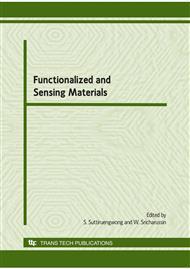p.672
p.675
p.679
p.683
p.687
p.691
p.695
p.699
p.703
Electrical Characteristics of DLC Deposited by RF Inductively Coupled Plasma Process
Abstract:
A Radio Frequency Inductively Couple Plasma Reactor (RFICP) was designed and set up for DLC deposition onto aluminum substrates using CH4-H2 admixture precursor gas. Plasma parameters of the discharge during the deposition process were measured using Langmuir probe technique. The structure and morphology of the DLC films were characterized by SEM and Raman spectroscopy. SEM images show granule morphology which yield smaller grain size with increasing of RF power. It was found that the structure and composition of DLC films are controlled by changes in the RF power. Raman spectrum of DLC films show two typpical modes of the graphite lattice labelled as ‘G’ and ‘D’ modes. The G peak position shift to higher wave number and the ratio of the peak intensity ID/IG increases with increasing RF power. DLC samples yield good ohmic characteristics with decreasing resistivity in films grown at higher RF power. Both electrical and structural characteristics indicated that the films contain more graphitic content of sp2 hybridization with increasing RF power in the plasma process.
Info:
Periodical:
Pages:
699-702
Citation:
Online since:
January 2010
Authors:
Keywords:
Price:
Сopyright:
© 2010 Trans Tech Publications Ltd. All Rights Reserved
Share:
Citation:


